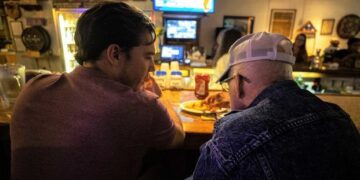BySheeka Sanahori
Published February 5, 2024
Through the 18th and 19th centuries, the predominant opinion in the United States was that Black Americans had no history, says Joy Bivins, director of collections and research services at the Schomburg Center for Research in Black Culture in Harlem, New York.
“Black history museums began to exist in the mid-20th century as a response to Black Americans not being in existing museums,” says Bivins.
Founded in 1925, the center was one of the first public spaces in the U.S. to delve into a history largely ignored or whitewashed by mainstream museums. It curated exhibits, protected artifacts, and shared first-hand perspectives from the Black community. It was a pioneer in what has become known as “first-voice” museums, says Malika Pryor, chief learning and engagement officer at the recently opened International African American Museum in Charleston, South Carolina.
She describes these museums as being born from community history rather than “stolen” artifacts—an initiative that sprouted with Indigenous communities. “We tell the stories of people who have either been completely left out of [mainstream] institutions or whose objects—as extensions of their lives—have been interpreted in a way that is not an [accurate] reflection,” she says.
These sites, from Washington, D.C., to Alabama, offer travelers an unfiltered immersion into the often overlooked and underreported narratives of Black American history.
History retold
As more Black culture and history museums open across the country, each presents more nuanced stories unique to their communities. For example, Virginia Beach plans to open The Virginia African American Cultural Center in 2028, highlighting Black Americans’ local contributions.
“That’s the role of public history, to guide people through learning and understanding about what happened in the past, what’s happening in the present,” says Lauren Cross, executive museum strategist for the National Juneteenth Museum, scheduled to open on Juneteenth 2025, in Fort Worth, Texas.
(In Charleston, Black history is being told through a new lens.)
Where to visit
Travelers looking for first-voice museums that comprehensively examine the Black community’s history and culture should start at Washington, D.C.’s National Museum of African American History and Culture. The newest Smithsonian Institution museum takes an unflinching look at the travails and triumphs of African Americans, illuminating more than 400 years of artifacts and historical information.
Other noteworthy museums include the Charles H. Wright Museum of African American History in Detroit. Established in 1965, this museum holds the world’s largest permanent collection of African American culture. Among the more than 35,000 artifacts, find displays on trailblazers in science and engineering and stained-glass windows by Samuel A. Hodge that depict stories of notable African Americans, from dancers to civil rights activists.
Atlanta’s National Center for Civil and Human Rights uses three levels of interactive galleries to draw parallels between the U.S. civil rights movement and global human rights struggles. The Legacy Museum: From Enslavement to Mass Incarceration in Montgomery, Alabama, tells the history of racism in America—from the slave trade to the era of Jim Crow and racial terror lynchings to the current mass incarceration crisis. Virginia’s Hampton University Museum, which opened as the first repository of Black culture in the U.S. in 1868, holds one of the world’s oldest collections of Kuba art from Central Africa
Historic landmarks and cultural heritage sites also allow travelers to glean information about Black history. For instance, tours of the Mary McLeod Bethune Council House in Washington, D.C., immerse visitors in the life of the pioneering 20th-century woman who set educational standards for today’s Black colleges and created space for Black people in government in her role as advisor to President Franklin D. Roosevelt. Ranger-led interpretive programs at the Little Rock Central High School National Historic Park in Arkansas educate travelers on the history of the Little Rock Nine and desegregation in education.
Bivins says travelers can also visit churches, restaurants, and other long-operating Black institutions to delve into culture.
“Our houses of worship are usually harbingers of history and stories. If you want to know who’s who, it’s there,” she says. “Places that are sites of political activity, restaurants that serve the food of people of the diaspora. That’s how you get into the story.”
Andre Taylor, an oral historian at Colonial Williamsburg, a living history museum in Virginia, says Mama Dip’s Kitchen in Chapel Hill, North Carolina, serves up both southern cuisine and Black culture. “You go in there, you eat, but you’ll quickly learn that this is a family institution, and individuals who know the different stories within the family will come out and tell you,” he says.
(As statues get torn down, which monuments should we visit?)
Cross adds that if you’re looking for more places to visit, the people who work at first-voice museums can recommend community-centered restaurants and other historic landmarks.
“The African American museums in your local community are an amazing resource and cannot be understated how important they are,” Cross says.
Sheeka Sanahori is a freelance journalist and video producer based in Atlanta Georgia, who writes about travel, history, and culture. Follow her on X and Instagram.
>>> Read full article>>>
Copyright for syndicated content belongs to the linked Source : National Geographic – https://www.nationalgeographic.com/travel/article/black-history-first-voice-museums

















![[News] China Makes Breakthrough in Chip Technology, Paving the Way for Lithography Advancements – TrendForce](https://earth-news.info/wp-content/uploads/2025/11/324664-news-china-makes-breakthrough-in-chip-technology-paving-the-way-for-lithography-advancements-trendforce-360x180.jpg)












